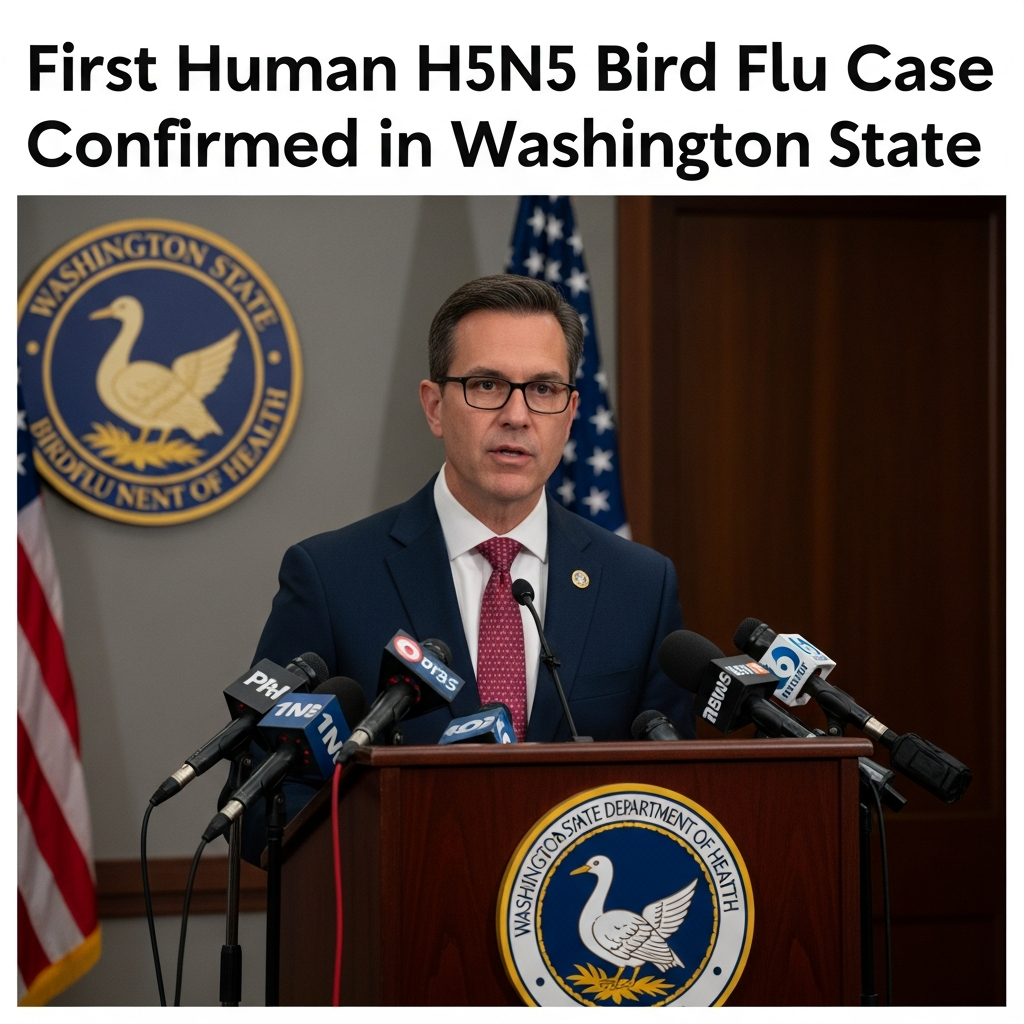The United States has recorded a groundbreaking case of avian influenza, commonly known as bird flu, in a Washington state resident. This incident marks a significant development for public health, as it is not only the nation’s first human infection since February but, more critically, the first-ever known human case of the H5N5 bird flu virus globally. While the novelty of this strain raises immediate questions, health authorities and experts currently maintain that the risk to the general public remains low. The patient, an older adult with underlying health conditions, is currently hospitalized, highlighting the ongoing vigilance required against evolving influenza viruses.
A New Avian Influenza Strain Emerges in Washington
State health officials in Washington confirmed the H5N5 bird flu diagnosis on Friday, November 14, 2025, following preliminary announcements on Thursday. The infected individual resides in Grays Harbor County on the Olympic Peninsula. This person experienced severe symptoms including a high fever, confusion, and difficulty breathing, necessitating transfers to hospitals in Thurston and King Counties. The severity of the illness underscores the urgency to gather comprehensive information about this new human infection.
Unraveling the H5N5 Mystery: What Makes it Different?
The distinction between the H5N5 bird flu and the more prevalent H5N1 virus lies in a specific protein. This protein plays a vital role in how the virus releases from an infected cell and spreads to surrounding cells. Richard Webby, a prominent flu researcher at St. Jude Children’s Research Hospital, explains this difference using an analogy. He compares them to “different brands of car tires” — both perform the same fundamental job, but each might be “better tuned for specific conditions” that scientists do not yet fully understand. Webby also suggested that H5N5 might show a preference for infecting particular types of birds.
The H5N5 virus first emerged in birds and mammals, including red foxes, cats, and raccoons, in eastern Canada during 2023. Research indicated that some infected animals harbored a key mutation, potentially allowing for easier transfer between mammals. Despite these differences, both Webby and the Centers for Disease Control and Prevention (CDC) have stated that H5N5 is not believed to pose a greater threat to human health than the H5N1 bird flu virus, which has been responsible for the vast majority of recent human infections.
The Broader Landscape of Avian Flu: A Global Challenge
The emergence of H5N5 comes against a backdrop of a widespread and concerning global avian influenza pandemic caused by the H5N1 virus. This highly pathogenic strain has reached panzootic status, affecting birds on every continent except Australia. The virus has demonstrated an enhanced ability to cross species barriers, infecting a diverse array of mammals including cats, goats, mink, tigers, seals, and dolphins. This ongoing animal pandemic presents significant challenges to wildlife, agriculture, and public health worldwide.
The Unexpected Spread to Dairy Cows
A significant and unexpected development in early 2024 was the emergence of H5N1 bird flu in dairy cows in the Texas Panhandle. This marked the first time the U.S. observed H5N1 in cattle, a phenomenon now present in at least 17 states. Infected cows typically survive but suffer from mastitis, an inflammation of the udder, and produce thick, yellowish milk. The virus spreads readily through contaminated milk in milking parlors. Recent milk testing in early 2025 identified new H5N1 spillovers in Nevada and Arizona, alongside a concerning new variant (D1.1) circulating in addition to the previously observed B3.13 variant. The long-term implications for cattle and the potential need for bovine vaccines are under active investigation.
How Bird Flu Spreads and Who is at Risk
For the Washington H5N5 case, health officials believe the most likely source of exposure was the resident’s backyard flock of domestic poultry, which had contact with wild birds. Generally, human infection with bird flu viruses typically occurs through close, unprotected contact with infected animals. This places individuals who work with or have recreational contact with potentially infected domestic or wild animals, such as farm workers on poultry and dairy farms, at an elevated risk.
In the poultry industry, primary defenses against H5N1 spread involve stringent biosecurity measures and widespread culling, which has resulted in the loss of over 166 million chickens in the U.S. since 2022. While poultry vaccines exist, the U.S. has been cautious about widespread vaccination due to concerns about potentially accelerating viral mutation and restrictions on international trade.
Assessing the Public Health Risk: Vigilance Amidst Uncertainty
Despite the novelty of the H5N5 strain in humans, the CDC has maintained that “no information would suggest the risk to public health has increased as a result of this case.” Most of the 70 reported human H5N1 infections in the U.S. during 2024 and 2025 were mild illnesses, predominantly affecting workers on farms. However, the severity of the Washington H5N5 case, with its acute symptoms, amplifies some expert concerns.
Virologists and epidemiologists stress that each human infection with an avian influenza virus provides an opportunity for the virus to mutate. These mutations could potentially enable the virus to transmit more easily between people, a scenario that could trigger a pandemic. Jennifer Nuzzo, director of the Pandemic Center at Brown University, highlighted the urgency to gather information, noting that the H5N1 virus circulating in dairy cattle is considered “one mutation away” from widespread human transmission. She emphasized that severe illness, as seen in this H5N5 case, intensifies these concerns. Conversely, Richard Webby maintains a more cautious stance, finding the new virus “interesting” but not “overly concerned yet.”
Global Efforts and Critical Challenges
The U.S. maintains stockpiles of personal protective equipment (PPE), antivirals, and human vaccine ingredients, which are effective against current H5N1 variants. However, a robust public health response faces several critical challenges. These include the reluctance of undocumented farm workers to seek medical attention, a potential erosion of public trust in science and public health agencies following the COVID-19 pandemic, and recent governmental setbacks in vaccine development funding and personnel.
Beyond Humans: Avian Flu’s Devastating Impact on Wildlife
Beyond the immediate concerns for human health, avian influenza, particularly H5N1, is taking a severe global toll on wildlife. Thousands of birds and hundreds of mammals in the U.S. alone have been infected. The virus rapidly spread through South America in late 2022, eventually reaching Antarctica and causing mass mortality events. These include the deaths of 40% of Peruvian pelicans and tens of thousands of seals. Endangered species, such as California condors and great skuas, have experienced devastating population declines. The unpredictable nature of the virus leaves experts uncertain about its future trajectory, with many feeling “on the precipice of something” unknown.
Practical Steps for Protecting Yourself from Bird Flu
While the overall public health risk to the general population remains low, individuals can take proactive steps to minimize their exposure to bird flu.
Protective Gear: The CDC recommends that individuals who work with or have recreational contact with potentially infected domestic or wild animals (including birds and cattle) wear protective gear such as gloves, masks, and eye protection.
Food Safety: Avoid consuming raw milk, unpasteurized cheeses, or undercooked poultry and eggs. Pasteurization and thorough cooking effectively kill the bird flu virus, making these products safe for consumption when properly prepared. It is also advised to avoid feeding raw meat or raw milk products to pets.
- Vigilance: Maintain good hygiene, especially after contact with animals or their environments. Report any unusual illness in domestic poultry or wild birds to local authorities.
- madison.com
- www.cbsnews.com
- apnews.com
- www.latimes.com
- www.wric.com
These measures contribute to ongoing public health efforts to monitor and control the spread of avian influenza.
Frequently Asked Questions
What is the H5N5 bird flu strain and why is this human case significant?
The H5N5 bird flu is a novel strain of avian influenza, and the recent case in Washington marks the first-ever known human infection globally. Its significance lies in this unprecedented jump to humans, distinguishing it from the H5N1 strain which has been responsible for most other recent human cases. Scientists note a difference in a specific viral protein between H5N5 and H5N1, suggesting it might be “tuned for specific conditions” or prefer different types of birds for infection. The Washington patient’s severe symptoms also raise questions among researchers about its potential impact.
How can individuals minimize their risk of exposure to bird flu?
Individuals can reduce their risk by avoiding close contact with potentially infected domestic or wild animals. For those who must handle such animals, like farm workers or hobbyists with backyard flocks, wearing personal protective equipment such as gloves, masks, and eye protection is recommended. Additionally, practicing strict food safety is crucial: avoid consuming raw milk, unpasteurized cheeses, or undercooked poultry and eggs, as proper pasteurization and cooking effectively eliminate the bird flu virus.
What is the current public health assessment of the H5N5 bird flu in humans?
Despite the groundbreaking nature of the H5N5 human case, both federal and state health officials, including the CDC, currently state that the overall risk to the general public remains low. They do not believe H5N5 poses a greater threat to human health than the H5N1 virus, which has caused most prior human infections. However, the severity of this specific case prompts some experts to urge caution, emphasizing that each human infection presents an opportunity for the virus to mutate and potentially adapt for easier human-to-human transmission, requiring ongoing vigilant surveillance.
In conclusion, the detection of H5N5 bird flu in a Washington resident signifies a new chapter in the ongoing global fight against avian influenza. While public health authorities currently assess the general public risk as low, this first-ever human infection with H5N5 underscores the unpredictable nature of these viruses. Continued surveillance, expert research, and proactive public health measures remain critical to understanding, monitoring, and responding to the evolving landscape of bird flu and protecting communities worldwide.



